Elk Calling 101:
Improving Your Elk Hunt
By Randy Tucker |
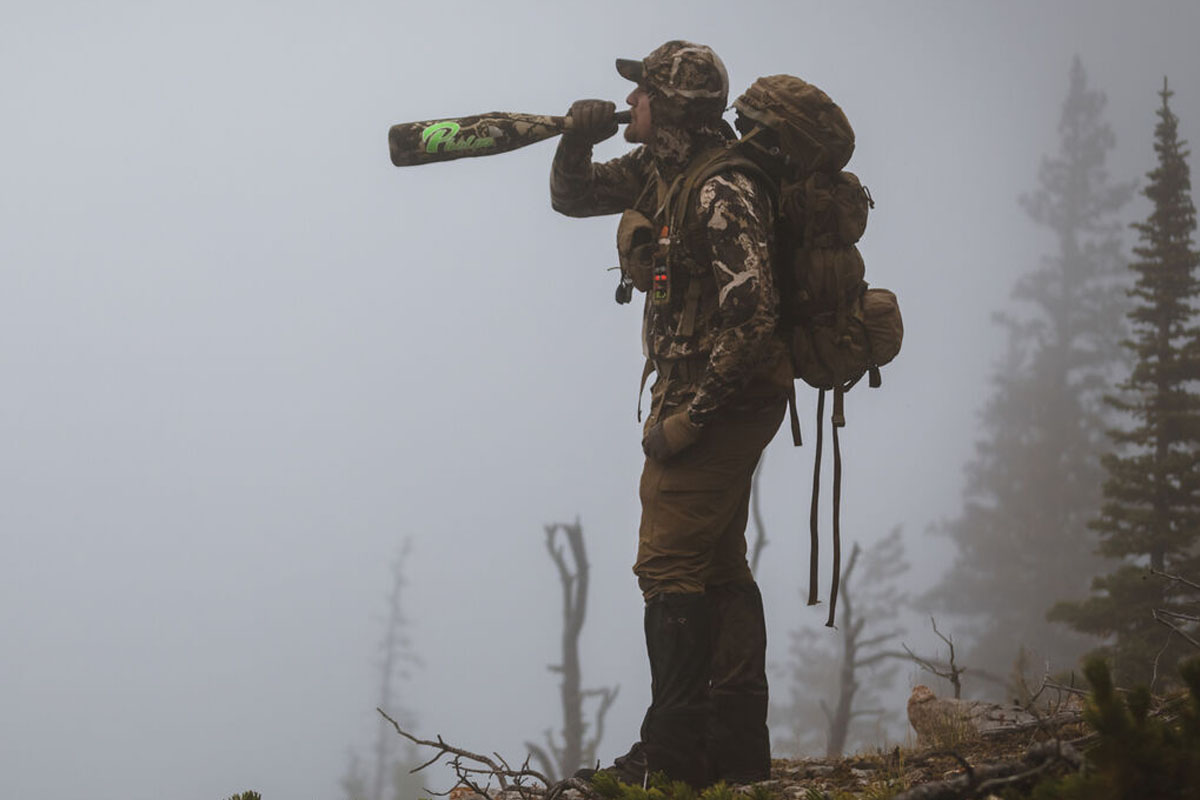
We’ve all heard the phrase, “Call of the wild”, but until you’ve been in the wild and heard the unmistakable high-pitched, throaty, trumpeting bugle of a bull elk on a clear mountain morning, you haven’t really experienced it.
Calling elk is a time-honored tradition dating back to primordial Native American hunters, and remains an effective method of finding, and bringing in bulls to this day. There are dozens, perhaps hundreds of styles of elk calls, but there are five main styles to discuss.
Using Your Elk Call to Hunt
The average bull elk weighs between 400 and 700 pounds, with antlers reaching seven feet or more in the air. You’d think they’d be easy to sneak up on, but they are among the most difficult of big game animals to locate and stalk. You can see, smell, or hear elk to locate them, and you can imitate the sound of an elk to draw them in, but first, you must find them.
Using Your Call to Locate Elk
Elk are quiet animals, but their calls can be heard clearly across mountain valleys and even in heavily wooded areas for miles. Mimicking the sounds they make can help you locate bulls when they answer back.
Bulls bugle and cows call, each with a distinctive sound. A bull will answer a bugle as a challenge from another bull or answer a cow call as it seeks to protect his harem. Both are great for locating elk and work best in the early morning or the late evening. As with their cousins the deer, elk are often nocturnal feeders, preferring the cover of darkness as protection from predators.
A cow call can be used to cover your advance through heavy brush, littered with broken branches that can snap, giving away your presence. With a cow call made just before walking over crunching deadfall, you can fool elk in the area into thinking that noise is just another cow coming up on the herd. Elk are quiet when feeding, but they make a lot of noise when moving through the timber.
If a bull answers your bugle, you can do it again and then listen for direction and try to judge the distance. One of the biggest thrills in the outdoors is having a “conversation” with a bull that repeatedly answers your bugle and advances toward you.
Using Your Call to Attract Elk
Attracting elk is different than locating them. To attract them you have to make it enticing for them to come to you. Bulls are territorial, they gather a harem of cows, and fight off any contending bulls that move in on them. During the rut they are especially on the fight, listening for any possible competitor and gathering cows at the same time. It is the best time for calling.
There are several sounds that different genders and ages of elk can create. That full high-pitched bugle is the mark of another bull, a big one, that needs to be challenged. A smaller bull emits a slightly different bugle. We may not notice the difference, but that big bull you’re trying to call in can tell.
There are cow calls, calf calls, (really more a mew than a call), and the call of a cow in estrus. This will all attract a bull with the estrus call during the rut often the most effective.
The most common mistake is to try to mimic a monster bull with an exaggerated call. This can scare away smaller bulls, and herd bulls may just move away with their cows in tow to avoid a fight.
The call of a smaller bull will often get the herd bull to try to locate and run him off. Don’t be surprised if during a back-and-forth call between you and another bull if a cow or smaller bull walks silently up on you. They’re inquisitive and solitary bulls will often investigate in the hope of luring away one or all of the herd bull’s cows. Cows are interested too, coming in to see who the new bull in the neighborhood is.
Types of Elk Vocalizations
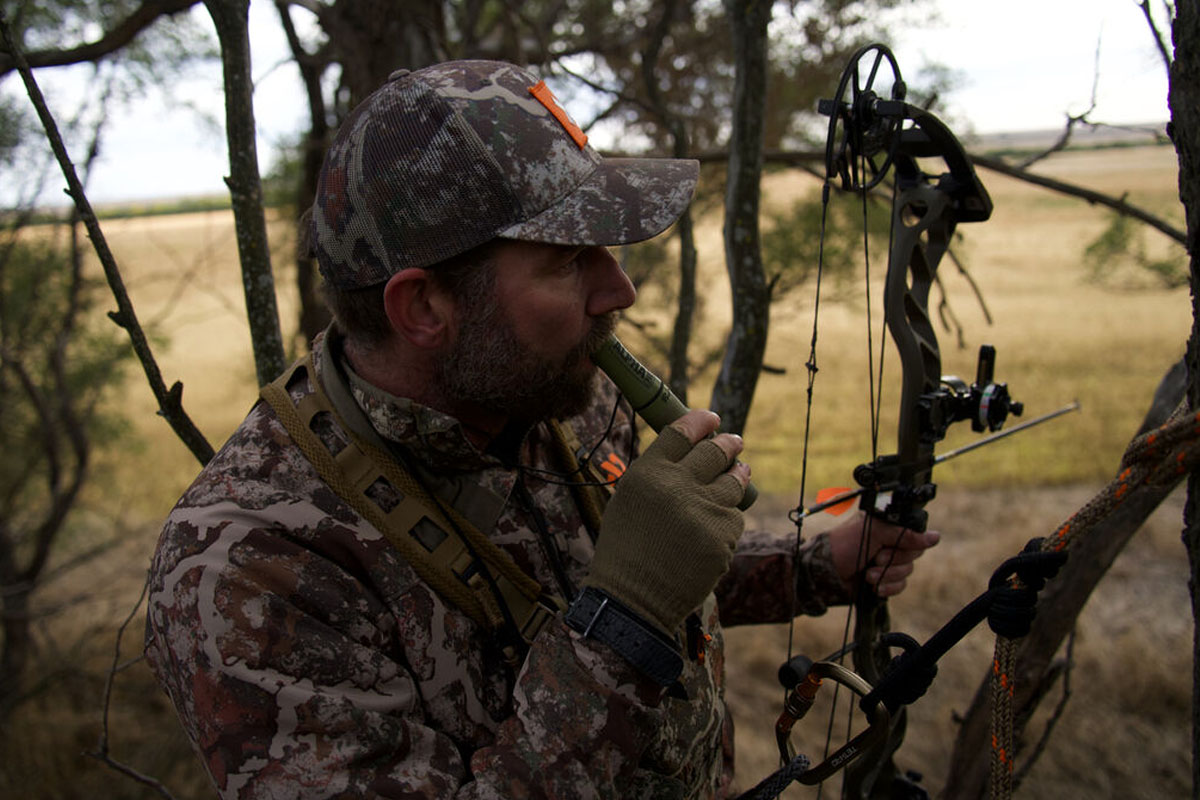
The goal of a successful call is to fool the elk into thinking you’re one of them. Elk are social animals most of the time, they enjoy hanging out together in herds both for protection and socialization.
Not all calls work in all settings, and the bugle is perhaps the most overused of elk calls. A bugle is a sign of dominance or a shout out to other elk in their often heavily forested environment to see who is out there. More often the herd will be quietly grazing together, sometimes cows will call for their calves and the calves will answer. These are all signs of contended elk just doing their thing out on the mountainside.
Calling to mimic these natural sounds of elk activity, while mixing in a few bugles to get the big bulls’ interest are the best vocalizations you can offer in getting them to move in.
The following table provides a list of the most important elk vocalizations you should be familiar with for improving your elk hunt.
| Vocalization | Description | How to Use it |
|---|---|---|
| Bugle | This is the most effective, but overused call. It is the sound of a big bull setting his boundaries. It is a sign of dominance but can also be used to locate other elk and to gather his cows. In the rut, this is a call to fight. | If there are signs that a large herd of elk is nearby that means a bull is with his harem. A bugle in the early morning or late afternoon will get his attention, and if he calls back, you may be able to get him to move in. It also works to bring in solitary cows and bachelor bulls. |
| Chuckle | A chuckle is the warmup to a full bugle. The bull starts with a few grunts, almost like a warmup then lets the bugle fly. Mastering the chuckle followed by the bugle is often the best call you can offer. | This is the preliminary move to a full bugle. Just throwing out random bugles without a chuckle first isn’t nearly as effective. |
| Chirps | This is a sound of a contended elk. The gentle sound of chirps, more described as quiet grunts are just the normal sounds a herd makes as it grazes across a hillside or moves easily toward water. | Chirps are great when a herd is close enough to hear moving in the timber. It can turn the herd, so it closes in on you. This is best done in total concealment. |
| Mew | This is elk conversation, meaning instruction between cow, calf, bull, and individual cow or cow to bull. It can mean a threat, an offer to fight, or just communication. | Along with the chirp, this is a way of getting elk to think everything is normal, so they’ll move into range. Since we don’t speak elk, use this sparingly since it could turn the herd away just as often as bring it closer. |
| Barks | Cows will be the first to bark, it’s a warning that something is wrong. A hunter or predator is nearby and the cows, and bulls too, will bark to let the herd know. | If you can get cows close enough to bark with you, the bull will be coming soon to investigate. This is the final close-range call to get elk in range of your location. Use this after the initial chuckle, bugle, and chirps for the final call |
Essential Elk Calls
There are hundreds of manufactured elk calls, and a few handmade calls sometimes based on the original designs used by Native American elk hunters for thousands of years. All these designs are broken down into the five basic styles listed below:
| Call | How it Works |
| Bugle | A bugle is a tube that resembles the trachea of an elk, and when combined with a diaphragm it creates a similar sound to a bugling bull elk. This is the best method of bugling, and the easiest to use, but takes a lot of practice to master. Some use a separate diaphragm with the tube to create cow calls and claim to make more realistic bull bugles too. |
| Reed | Reed calls produce excellent non-bugling elk sounds by blowing into it. They’re great for mews, barks, and chirps, and create chuckles easily before bugling. They don’t have the range or resonance of a bugle and can freeze in cold temperatures since the hunter has to play them like a woodwind instrument, getting saliva on the reed. |
| Diahragm | A diaphragm is the favorite call of experienced elk hunters. It takes a tremendous amount of practice to master this call, but it has a lot of advantages. The diaphragm is entirely in the hunter’s mouth, freeing his hands to use binoculars or to sight in on an approaching bull. It can produce every sound a bull, cow, or calf can make in the hands (or mouth) of an experienced user. |
| Manual | A manual call is similar to a reed in sound production but requires the hunter to squeeze a bulb below the reed to force air, and subsequent sound, through it. It won’t freeze in cold weather, but it takes one hand to use for an experienced hunter, and two for those just learning to call. |
| Electronic | Adapted from varmint hunting technology, electronic calls vary from state to state for legal use. Always check hunting regulations before you go to the field. Electronic calls can be used with a cell phone, or in a standalone device. They can be a single device or connected via Bluetooth to remote speakers. Electronic calls don’t sound as natural as the other devices but are much easier to use. |
Elk Calling Techniques
Sometimes the best calling technique is not to call, at least not to call often. Elk are not 7th-grade girls, they don’t just call to hear their head rattle. Elk are social animals, but they don’t make sounds as ducks and geese do. Too many take the duck call technique to the mountains in pursuit of elk and scare far more off than they attract. The following are elk calling techniques I’ve found actually help improve my elk hunt.
Try to Duplicate Not Just Imitate an Elk Call
Having a reliable and consistent call is great, but a monotone call, with no volume variance, can be just as bad as an off-tone call. Elk are like every other mammal when it comes to verbalizing, they vary in tone, volume, and frequency. It is a fine line to follow since too much change can spook that big bull, but too much of the same can alert him that you’re not another elk communicating through the trees.
Elk have different voices just like humans do, some border more on the bass side of the spectrum, and others might sing soprano as a comparison. One steady tone doesn’t do it. Vary the pitch, frequency, and volume of your calls, but don’t overdo them.
Yes, it is difficult, but practice will improve your calling. A good idea is to record and play back your calls in the off-season so you can hear what you sound like to an elk.
A Good Sound Mix Improves Your Calls
We like to break down elk calls to chirps, mews, barks, and chuckles, but those are just generic terms for dozens, perhaps hundreds of unique sounds that can emanant from an elk herd. A single, constant cow call won’t do the job.
Instead, listen to recordings of estrous calls and learn to match them. Mix those estrous calls with raspier sounds, and longer drawn-out cow sounds, that border on a bull’s bugle. Don’t underuse the chirp. Of all the sounds elk make, a chirp is the most common, it is the small talk of the elk kingdom, sounds that a calm herd feeding in a meadow or moving slowly through the trees makes as a way of knowing where each other are, and to provide comforting sounds to the rest of the herd.
Convince a bull that you are a solitary cow that is away from his harem, a rival bull, or a stray group of cows and calves and he’ll come on the run.
Finding the Right Cadence Improves Your Calling
You might think of it as the beat to a dance song in human terms, but cadence is a key element of good calling techniques. The speed, variation, and volume of a mix of different elk sounds make your calling realistic. This means throwing in a bugle once in a while, but concentrating on a random rhythm of chirps, with standard mews thrown in, and an occasional mew that ends with a rising, whining tone.
Elk have a cadence naturally, it is random, but if you listen to a herd you can hear it. In the elk world it is similar to the cadence humans use while marching in military drills, or at athletic practice. Cadence focuses a group into one homogenized movement. Elk will respond by answering your calls made in the proper cadence and try to find you.
Making a Little Noise Will Improve Your Calling
Elk are noisy, they can’t help it. They’re huge animals with bulls pushing 800 pounds, and they live in areas littered with downed timber, broken limbs, and rocks. To increase the realism of your calling make a little noise. It is counterintuitive to many hunters who grew up with whitetail or turkey hunting where stealth is important but makes some noise.
Before you begin a call sequence, throw a few rocks, break a stick or two, or just step on some underbrush. Make your call then swat a nearby tree with a branch, or just grab a limb and spring it back so it sways against nearby brush. These techniques will help convince the elk you’re calling that you are another elk on the move. Sitting completely still is a warning sign to elk that you could be a threat.
Take a Few Pauses When Calling
One of the biggest mistakes novice callers can make is staying on the call too long. Elk are social animals just like people. We avoid those talking heads that never take a pause and don’t let someone else speak, elk do as well.
Call, then take a break for a few minutes. When you call again, vary the sequence of sounds. Chirps are always okay but start with a bark or a soft bugle, then a few mews, and maybe a mew with a whining sound at the end.
Take a break and open with a bugle the next time, followed by other sounds. The sequence of sounds is your choice, but silence is a key technique. Don’t overuse your calls.
If You’re Hunting in a Group, Let Someone Else Call
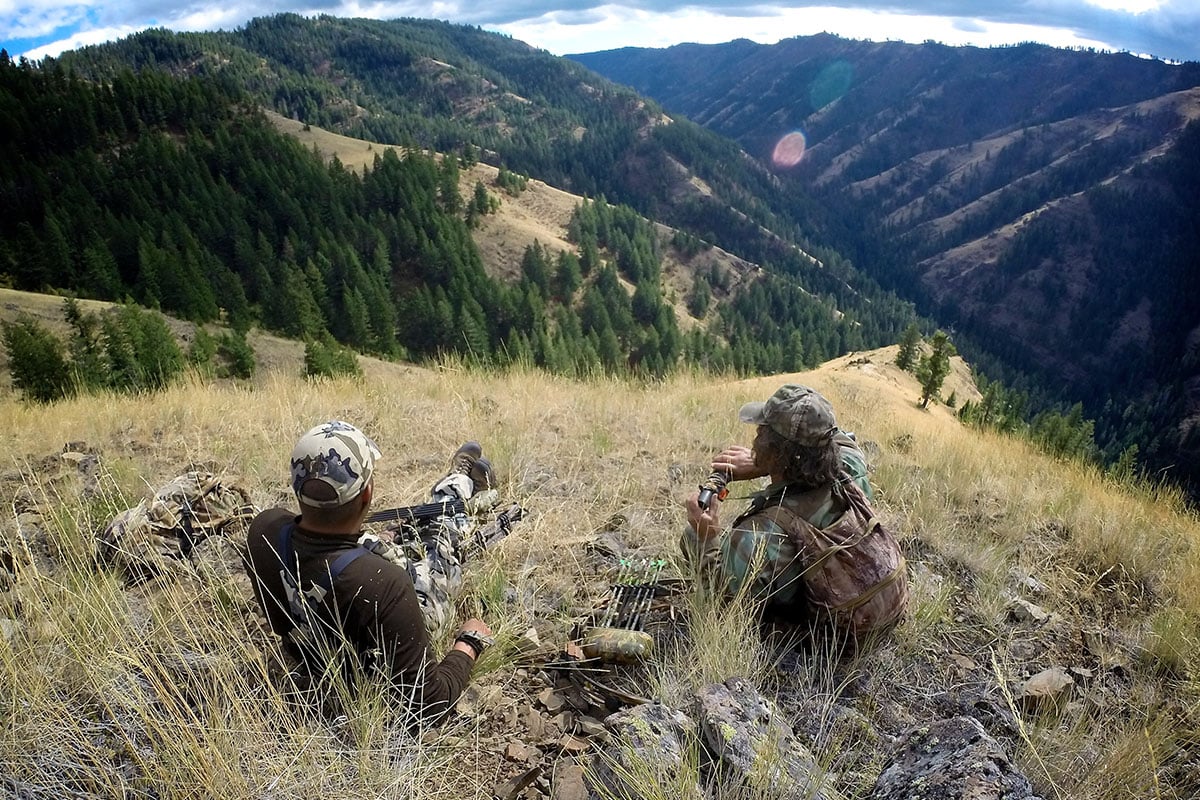
The best elk callers are never the same. You can recognize the differences in tone, duration, and volume from one caller to the next just like you can recognize someone’s voice on the phone. Elk have different voices, and so should people who are calling them.
Often a group will rely on one person to make all the calls. They may be better at it, but the monotony of that single voice can trigger elk. Instead, take turns calling. You don’t want bugles on top of each other, but chirps, mews, and barks made by different callers take on an extra level of realism.
Passing around the sound is the key. It will convince herd bulls that there are multiple cows, calves, or challenging bachelor bulls nearby and get their interest.
How to Use a Call in Heavily Trafficked Areas
Elk are popular game animals, people flock to areas they habitat. Too many humans spook elk, making them suspicious and difficult to attract. The carrot and stick approach works when calling elk, just like it does in motivating different people.
The carrot is the cow call, with chirps, chuckles, mews and calf calls mixed in. These calls are calming to spooked elk and will help settle them down so they’ll move toward you. It is a great technique to use if you’ve heard dozens of bugles echoing off the hills from other people in the area.
The stick is a loud bugle timed to overwhelm a herd bull’s bugle. This will tick him off, making him think another bull is trying to move in on his herd and the testosterone will flow. This is a great technique if there aren’t a lot of elk bugling, or other humans messing up the opportunity. Timing is key, you have to be ready to answer a bugle in just a few seconds to annoy the herd bull with your challenge.
Elk Calling Tactics
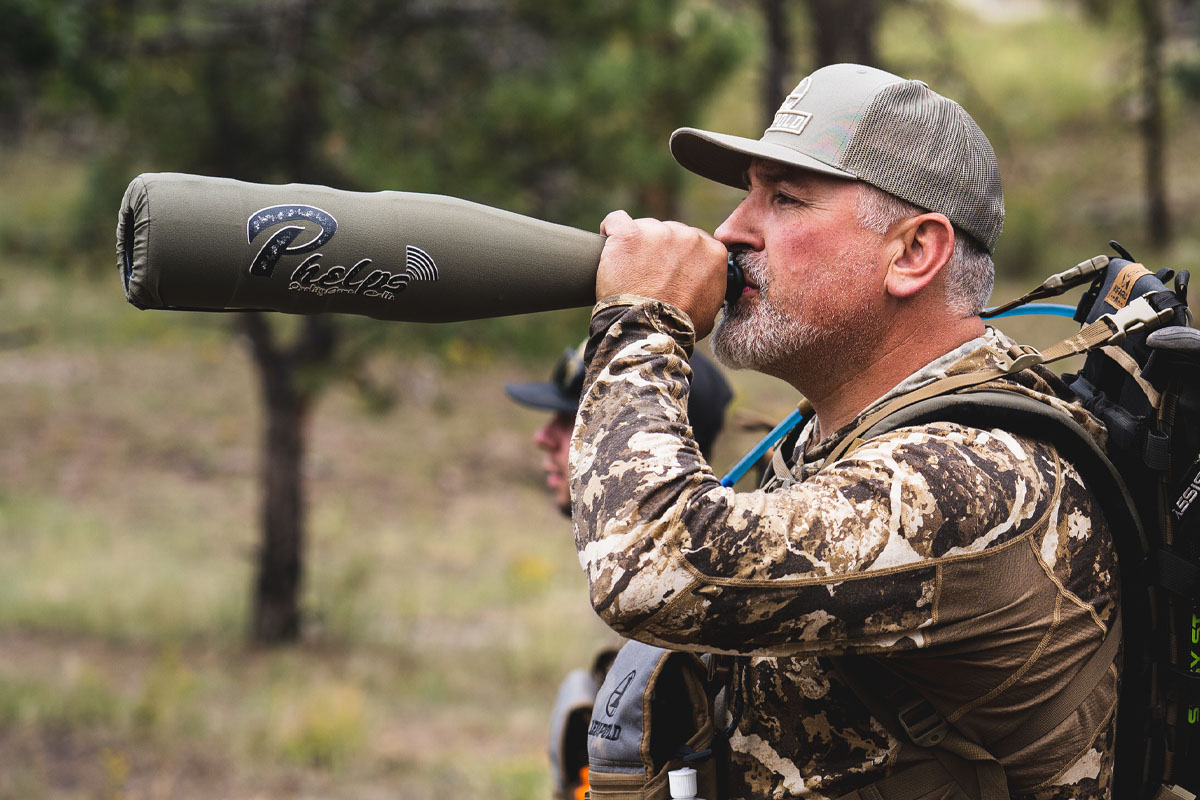
Patience is the greatest tactic you can use in calling elk. Make a call, wait for a response, and if you get one, don’t answer right away. Sounding too eager is a dead giveaway to a wary herd bull, and with the advent of modern calls, the mountains are offered filled with people calling all day, teaching the elk to identify what is real and what is not.
Strategy, Use the Off-Season to Improve Your Calling
Strategy is important, how, when, how loud, and how long your call or calls should bring greater chances of success in calling an elk. Scouting in the off-season to locate the summer herd and adapting a game plan to that information to call in the fall improves your success rate. Strategy involves where you’ll set up, which call you’ll use, which style of call you’re going to send out, what time of day you expect to call, the incline or decline you’ll be near, and how to avoid other humans. Get these in line and you’ll improve your odds dramatically.
How to Use the Best Calling Sequence
The sequence of your call is equally as important as the quality of the call. Tooting away on your bugle doesn’t increase your chance of getting an answering call from a bull, it decreases it to the point of futility. A call, with a good pause of several minutes, then moving position and calling again is the best way to get a bull’s attention.
How to Communicate with a Bull
Once a bull answers, don’t go ballistic and reply right away. As herbivores, subject to predation by wolves, cougars, and grizzlies, not to mention man, elk are wary. An out-of-the-ordinary sound, even if it’s an authentic-sounding call sent too often will set them off and they’ll walk away from that call. Make a little noise by stepping on deadfall, whacking a tree with a limb, or rustling pine branches, elk are noisy. If a call comes from a silent location, it will warn them. Calling too often makes elk move away from you.
How to Use Calls When Cows are in Estrous
Bulls enter the rut when cows are cycling, estrus brings on the aggressive nature of bull elk. Using estrous to your benefit with cow calls is a great calling technique. The bulls are after as many cows as they can manage and will breed when one of their cows enters estrus. That is the essence of the rut, and why some states limit hunting during the rut to ensure the next generation of calves the following spring. This is a great time to use cow calls mixed with light bugles, creating the impression that a smaller bull is moving in on a herd bull’s cows.
Calling a Herd Bull
There is nothing special about a herd bull except that he will be the strongest, most aggressive, and almost always the biggest bull on the mountain. Herd bulls will come in on the challenge of a bugle, they’ll follow cow calls, and be attracted by mews and chirps. The bugle of another bull in the area will send the herd bull into a rage to find the challenger and this is the time to mix many calls together to attract a herd bull.
How to Call Bachelor Bulls
These guys often come in quicker than a herd bull since they’re trying to sneak in on the side and take one of the larger bull’s cows. They often appear almost magically within a few yards of you. They’re in stealth mode, moving quietly so they don’t let the herd bull know they’re there. Some of them are great bulls, but if you don’t pay attention as you’re calling they can move in silently, notice you, and move away without you ever knowing they were there. Bachelor bulls will move in on cow calls, mixed mews, and chirps, but are wary of the louder bugles a herd bull makes since they want to sneak in on a harem without getting thrashed by the bigger herd bull.
How to Find the Best Setup
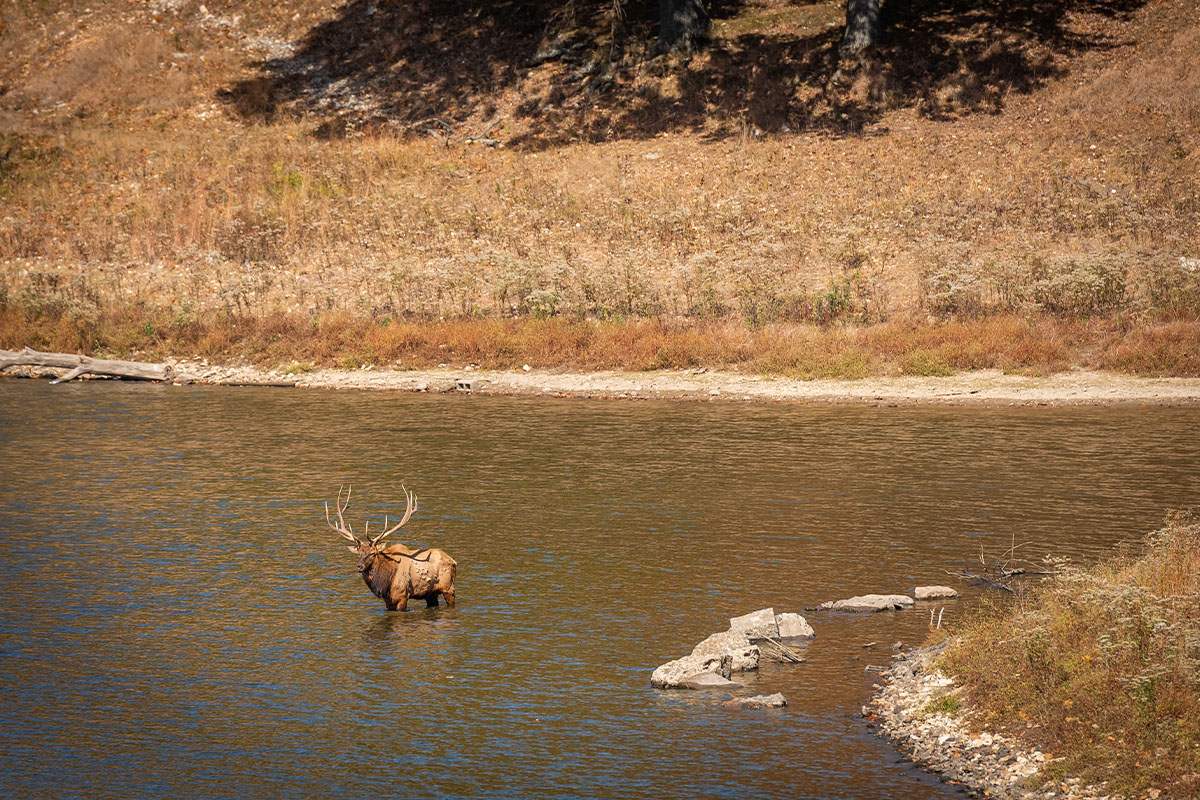
This is part of the scouting you did in the preseason. Finding a vantage point above a waterhole in a dry area is always good. So is the point where two draws come together in a rise. You can glass more country from a good setup position. An early morning call, with another a few minutes, later breaks the silence and lets the elk know another bull is in the area. Don’t overdo the calls, patience is your best friend, and your setup should allow a clear view. When you get an answering bugle, wait a few minutes, and throw in a cow call or two, with a few mews and chirps, it creates a more realistic sound pattern for an approaching bull.
Using Natural Cover to Your Advantage
It’s like Goldilocks, too much cover and you can’t see an approaching bull, too little cover and he’ll see you and head the other way. Finding just the right amount of cover is the key to calling without giving away your position. Cover should work with your camouflage to make you just part of the scenery to an elk. Blend in and wait is how good cover works. You’ll be able to call elk from a distance initially and then with other calls as they approach with good cover and not startle them by having to move as you switch calls.
Be Easy to Find
Too much cover, on a right ridge or up a steep draw is detrimental. Elk are curious and will approach an authentic call but they’re not going to cross a river, climb several hundred yards up a steep hill, or cross acres of broken, felled timber to get to you. Make it easy on yourself and the elk. Find a spot where they can easily approach your position as you call, but use a ridge, bluff, or heavy brush that hides as they move in.
How to Have Your Equipment at the Ready
Have your call ready and within easy reach at all times. Those final chirps or barks are often the difference when you can hear the nearby deadfall snapping on the approach of a big bull. The bugle will get their attention, and bring them closer, but it’s those final mews and chirps that get them within your sight. Odds are you’ll have a couple of calls for different uses, have them handy when it’s time to continue drawing elk closer.
Conclusion
The learning curve might appear a bit steep because it is. Elk calling is the apex of big game adventure for most North American hunters. You can attract moose, deer, bear, or pronghorn but you can’t call them, that’s reserved for elk.
The first step is choosing which call you want to try. There are choices and each one comes with advantages and disadvantages.
Once you have a call selected, you’ll have to decide how you’re going to use that call. Are you trying to locate elk, or are you trying to call in a bull? The techniques are different and require skill to master.
Are you going to try and mimic just a bugle? Or do you want to add a few chuckles in front of the bugle for a more realistic sound? Do you just want to call bulls, or is a cow call appropriate? How much noise should you make when calling? Chirps, mews, and barks add reality to your calling but when is it too much? These are all considerations.
You know the call you want to try, but do you know what it takes in terms of skill and practice to use one successfully? Find out before you hit the mountains.
You’ve found the right call for you, you know the differences between the various sounds it can produce and have an idea of when to use each sound, but how do you put it all together?
You consider all the variables listed above from location to frequency, to cover, position, set up, and the different personalities and techniques used by herd bulls, bachelor bulls, and both when cows are in estrus.